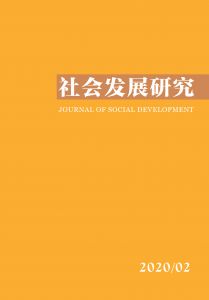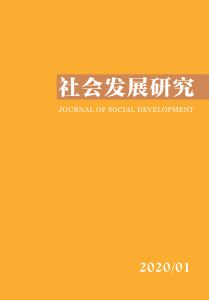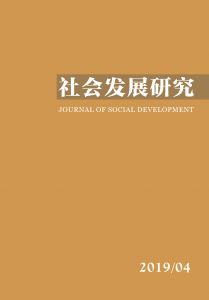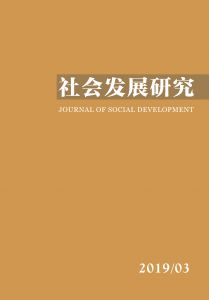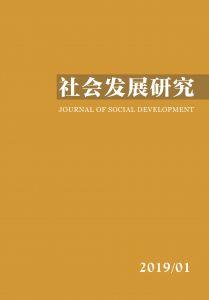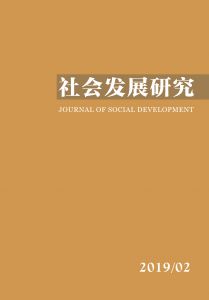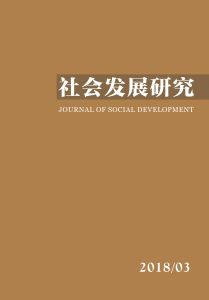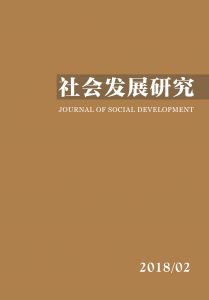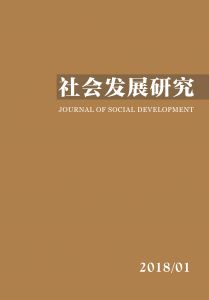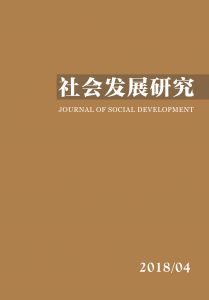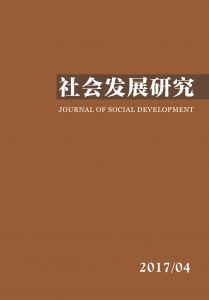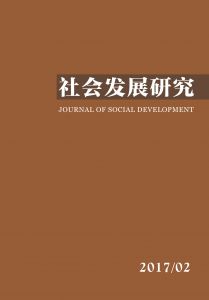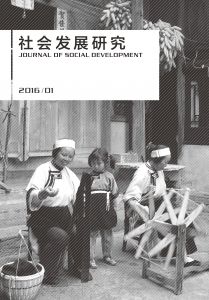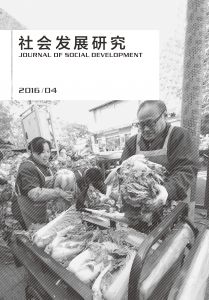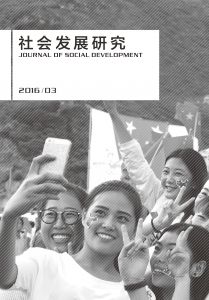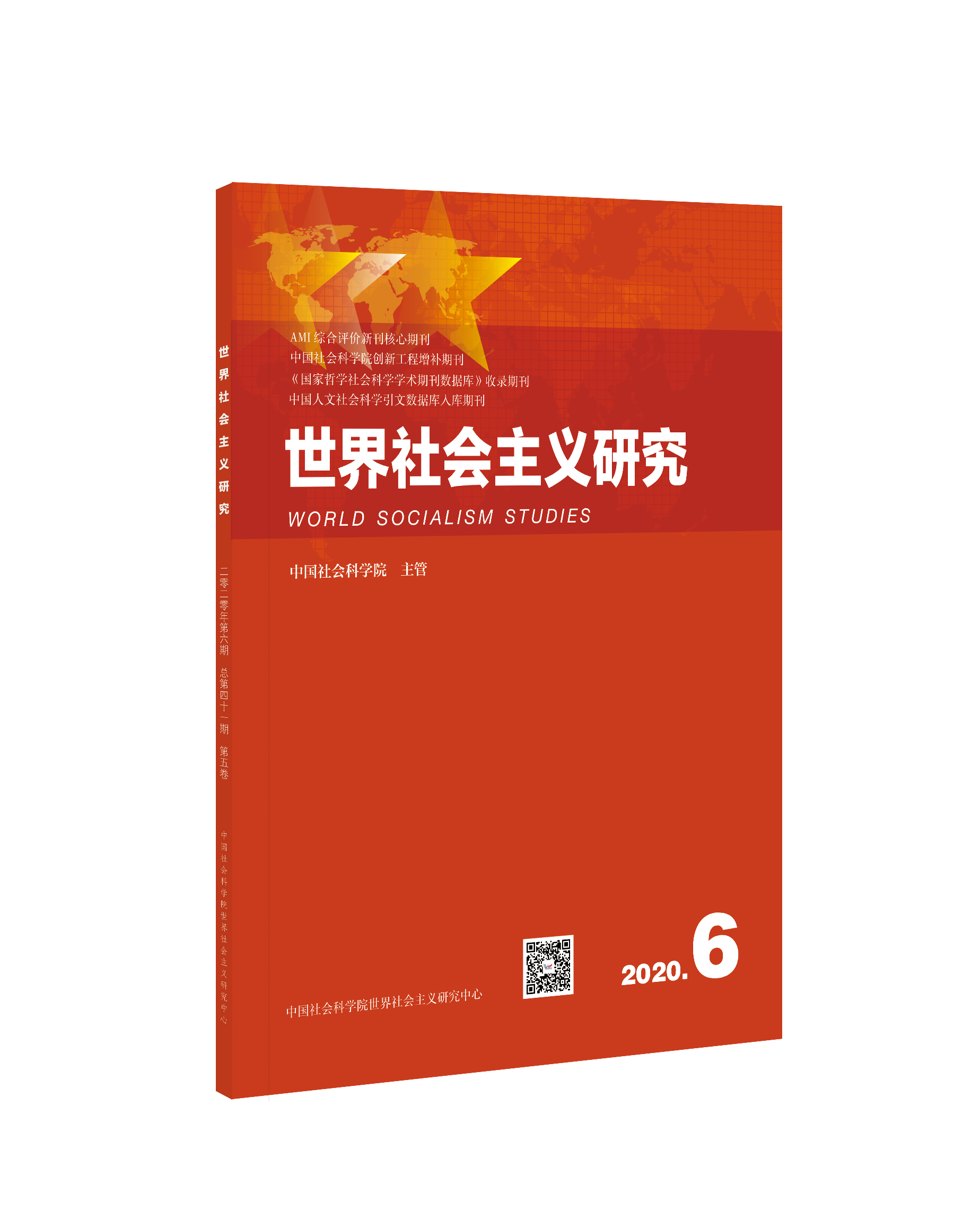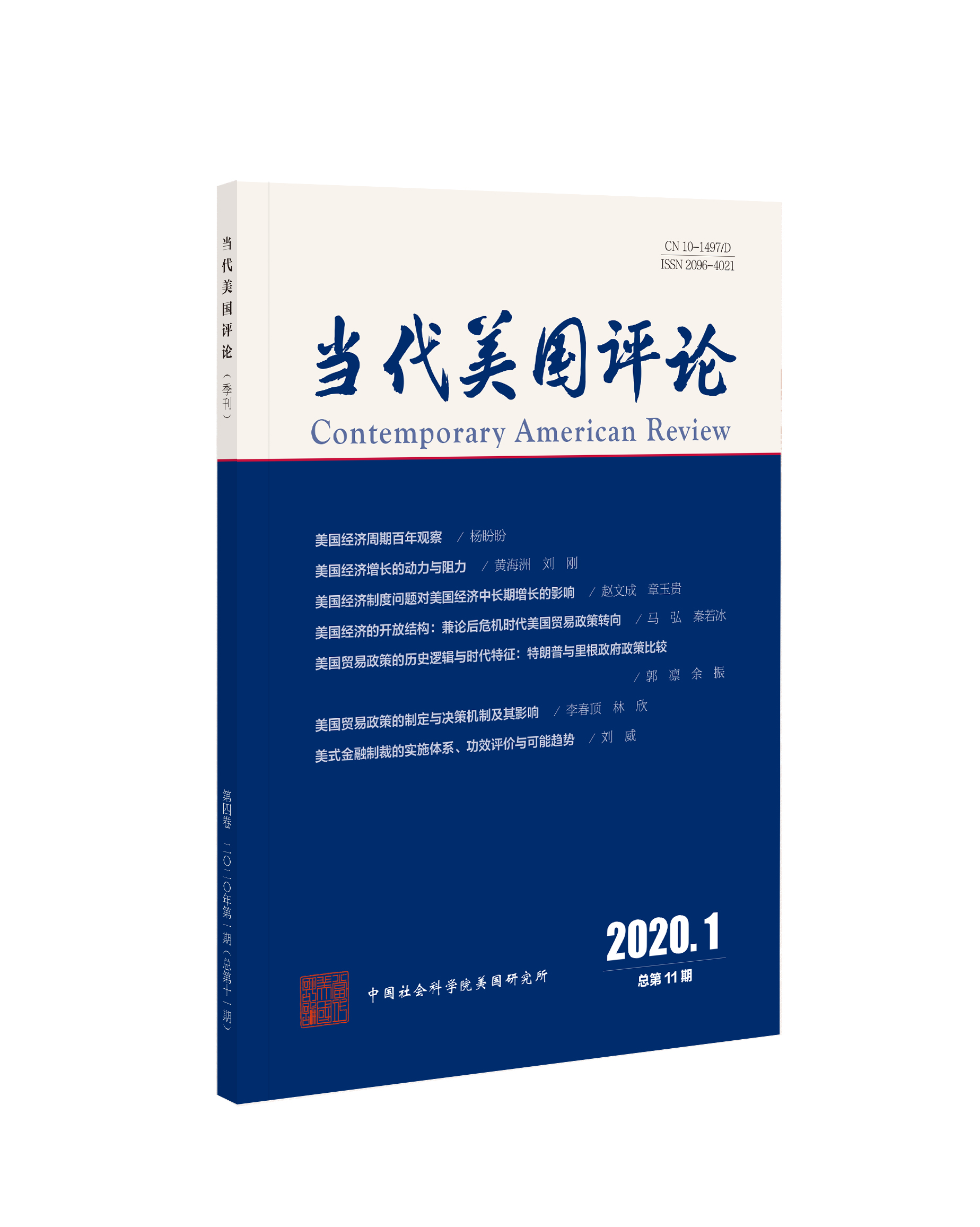最新期刊
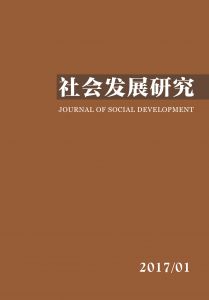
目录
过往期刊
参考文献
-
编委会
-
·论文·
-
教育影响健康的群体差异(2005—2012):资源替代与劣势叠加
-
父母外出务工对农村留守儿童健康的影响
-
代际社会流动与精神健康
-
多元社区视野下的旧城空间
-
空间重构与移民社区融入
-
政府购买背景下草根养老组织社会资本建构的行动逻辑
-
家庭志愿服务:欧美经验及对我国政策设计的启示
-
网络游戏与底层青年亚文化的形成
-
-
·调查报告·
-
横渠村:乡土社会中的农民合作
-
排队还是“走后门”
-
-
·马克思主义学习与研究专栏·
-
当代中国廉政话语建设研究
-
中国特色地区社会治理模式探索
-
-
·研究述评·
-
人工器物与制度
-
-
·书评·
-
动物精神的社会学逻辑
-
-
英文目录及摘要
-
稿约
-
版权页
按年份浏览:
- 全部
- 2020
- 2019
- 2018
- 2017
- 2016
- 2015
- 2014
[1][1]陈云松、张翼,2015,《不平等的城镇化效应与社会融合》,《中国社会科学》第6期。
[2][2]邓曲恒,2010,《中国城镇地区的健康不平等及其分解》,《中国社会科学院研究生院学报》第5期。
[3][3]洪岩璧,2015,《Logistic模型的系数比较问题及解决策略:一个综述》,《社会》第4期。
[4][4]胡安宁,2014,《教育能否让我们更健康》,《中国社会科学》第5期。
[5][5]黄洁萍、尹秋菊,2013,《社会经济地位对人口健康的影响》,《人口与经济》第3期。
[6][6]焦开山,2014,《健康不平等影响因素研究》,《社会学研究》第5期。
[7][7]吉黎,2013,《城市化有利于健康吗?》,《世界经济文汇》第3期。
[8][8]李建新、夏翠翠,2014,《社会经济地位对健康的影响》,《人口与经济》第5期。
[9][9]刘晓昀,2010,《农村劳动力流动对农村居民健康的影响》,《中国农村经济》第9期。
[10][10]马默特,2008,《地位决定你的健康》,冯星林、王曲译,北京:中国人民大学出版社。
[11][11]齐良书,2006,《收入、收入不均与健康:城乡差异和职业地位的影响》,《经济研究》第11期。
[12][12]齐亚强,2014,《自评一般健康的信度和效度分析》,《社会》第6期。
[13][13]齐亚强、牛建林,2015,《地区经济发展与收入分配状况对我国居民健康差异的影响》,《社会学评论》第2期。
[14][14]王甫勤,2011,《社会流动有助于降低健康不平等吗?》,《社会学研究》第2期。
[15][15]王甫勤,2012,《社会经济地位、生活方式与健康不平等》,《社会》第2期。
[16][16]吴愈晓,2011,《劳动力市场分割、职业流动与城市劳动者经济地位获得的二元路径模式》,《中国社会科学》第1期。
[17][17]薛新东、刘国恩,2012,《社会资本决定健康状况吗?》,《财贸经济》第8期。
[18][18]叶华、石爽,2014,《转型期劳动力的教育差异与健康后果》,《中山大学学报》(社会科学版)第4期。
[19][19]赵忠,2006,《我国农村人口的健康状况及影响因素》,《管理世界》第3期。
[20][20]郑冰岛、吴晓刚,2013,《户口、“农转非”与中国城市居民中的收入不平等》,《社会学研究》第1期。
[21][21]邹钦培等,2014,《重庆市城乡居民健康不公平性分析》,《上海交通大学学报》(医学版)第9期。
[22][22]Becker,Gary S.1993,Human Capital:A Theoretical and Empirical Analysis,with Special Reference to Education . Chicago:The University of Chicago Press.
[23][23]Bird,Chloe E.,Peter Conrad,Allen M.Fremont,& Stefan Timmermans (Eds.).2010,Handbook of Medical Sociology . Nashville:Vanderbilt University Press.
[24][24]Bjelland,Ingvar,Steinar Krokstad,Arnstein Mykletun,Alv A.Dahl,Grethe S.Tell,& K.Tambs.2008,“Does A Higher Educational Level Protect Against Anxiety and Depression?The HUNT Study.” Social Science & Medicine 66(6):1334-1345.
[25][25]Chen,Feinian,Yang Yang,& Guangya Liu.2010,“Social Change and Socioeconomic Disparities in Health over the Life Course in China:A Cohort Analysis.” American Sociological Review 75(1):126-150.
[26][26]Culter,David M.,& Adriana Lleras-Muney.2006,“Education and Health:Evaluating Theories and Evidence.” NBER.
[27][27]Elo,Irma T.2009,“Social Class Differentials in Health and Mortality:Patterns and Explanations in Comparative Perspective.” Annual Review of Sociology 35:553-572.
[28][28]Everett,Bethany G.,David H.Rehkopf,& Richard G.Rogers.2013,“The Nonlinear Relationship Between Education and Mortality:An Examination of Cohort,Race/Ethnic,and Gender Differences.” Population Research and Policy Review 32(6):893-917.
[29][29]Grossman,Michael.1972,“On the Concept of Health Capital and the Demand for Health.” Journal of Political Economy 80(2):223-255.
[30][30]Hu,F.B.,Y.Liu,& W.C.Willett.2011,“Preventing Chronic Diseases by Promoting Healthy Diet and Lifestyle:Public Policy Implications for China.” Obesity Reviews 12(7):552-559.
[31][31]Kawachi,Ichiro,Nancy E.Adler,& William H.Dow.2010,“Money,Schooling,and Health:Mechanisms and Causal Evidence.” Annals of the New York Academy of Sciences 1186:56-68.
[32][32]Krieger,N.,D.R.Williams,& N.E.Moss.1997,“Measuring Social Class in US Public Health Research:Concepts,Methodologies,and Guidelines.” Annual review of Public Health 18:341-78.
[33][33]Lahelma,Eero.2010,“Health and Social Stratification.” pp.71-96 in The New Blackwell Companion to Medical Sociology ,edited by William C.Cockerham.West Sussex:Wiley-Blackwell.
[34][34]Li,Hongbin & Yi Zhu.2006,“Income,Income Inequality,and Health:Evidence from China.” Journal of Comparative Economics 34 (4):668-693.
[35][35]Link,Bruce G.,& Jo Phelan.1995,“Social Conditions as Fundamental Causes of Disease.” Journal of Health and Social Behavior 35(Extra):80-94.
[36][36]Lowry,Deborah,& Yu Xie.2009,“Socioeconomic Status and Health Differentials in China:Convergence or Divergence at Older Ages?” Population Studies Center,University of Michigan,http://www.psc.isr.umich.edu/pubs/pdf/rr09-690.pdf.
[37][37]Lynch,Scott M.2003,“Cohort and Life Course Patterns in the Relationship between Education and Health:A Hierarchical Approach.” Demography 40(2):309-31.
[38][38]Masters,Ryan K.,Robert A.Hummer,& Daniel A.Powers.2012,“Educational Differences in U.S.Adult Mortality:A Cohort Perspective.” American Sociological Review 77(4):548-72.
[39][39]Matthews,Sharon,Orly Manor,& Chris Power.1999,“Social Inequalities in Health:Are There Gender Differences?” Social Science & Medicine 48(1):49-60.
[40][40]Mirowsky,John,& Catherine E.Ross.2003,Education,Social Status,and Health . New York:Aldine de Gruyter.
[41][41]Muennig,Peter,& Steven H.Woolf.2007,“Health and Economic Benefits of Reducing the Number of Students per Classroom in US Primary Schools.” American Journal of Public Health 97(11):2020-27.
[42][42]Muennig,Peter,Dylan Robertson,Gretchen Johnson,Frances Campbell,Elizabeth P.Pungello,& Matthew Neidell.2011,“The Effect of an Early Education Program on Adult Health:The Carolina Abecedarian Project Randomized Controlled Trial.” American Journal of Public Health 101(3):512-16.
[43][43]Popkin,Barry M.2008,“Will China’s Nutrition Transition Overwhelm Its Health Care System And Slow Economic Growth?” Health Affairs 27(4):1064-76.
[44][44]Rogers,Richard G.,Bethany G.Everett,Anna Zajacova,& Robert A.Hummer.2010,“Educational Degrees and Adult Mortality Risk in the United States.” Biodemography and Social Biology 56(1):80-99.
[45][45]Ross,Catherine E.,& Chia-Ling Wu.1995,“The Links Between Education and Health.” American Sociological Review 60(5):719-45.
[46][46]Ross,Catherine E.,& John Mirowsky.2006,“Sex Differences in the Effect of Education on Depression:Resource Multiplication or Resource Substitution?” Social Science & Medicine 63(5):1400-13.
[47][47]Ross,Catherine E.,and John Mirowsky.2010a,“Why Education Is the Key to Socioeconomic Differentials in Health.” pp.33-51 in Handbook of Medical Sociology ,6th ed.edited by C.Bird,P.Conrad,A.Fremont,and S.Timmermans.Nashville:Vanderbilt University Press.
[48][48]Ross,Catherine E.,and John Mirowsky.2010b,“Gender and the Health Benefits of Education.” The Sociological Quarterly 51(1):1-19.
[49][49]Schafer,Markus H.,& Soyoung Kwon.2012,“Cohorts and Emerging Health Disparities:Biomorphic 62 Trajectories in China,1989 to 2006.” Journal of Health and Social Behavior 53(4):515-32.
[50][50]Schultz,Theodore W.1961,“Investment in Human Capital.” The American Economic Review 51:1-17.
[51][51]Walsemann,Katrina M.,Gilbert C.Gee,& Annie Ro.2013. “Educational Attainment in the Context of Social Inequality:New Directions for Research on Education and Health.” American Behavioral Scientist 57(8):1082-104.
[52][52]Winkleby,Marilyn A.,Darius E.Jatulis,Erica Frank,& Stephen P.Fortmann.1992,“Socioeconomic Status and Health:How Education,Income,and Occupation Contribute to Risk Factors for Cardiovascular Disease.” American Journal of Public Health 82(6):816-20.
[53][53]Wu,Jing,Yuanli Liu,Keqin Rao,Qi Sun,Juncheng Qian,& Zhu Li.2004,“Education-Related Gender Differences in Health in Rural China.” American Journal of Public Health 94(10):1713-16.
[54][54]Wu,Xiaogang,& Donald J.Treiman.2004,“The Household Registration System and Social Stratification in China:1955-1996.” Demography 41:363-84.
[55][55]Zajacova,Anna.2006,“Education,Gender,and Mortality:Does Schooling Have the Same Effect on Mortality for Men and Women in the US?” Social Science & Medicine 63(8):2176-90.
[56][56]Zajacova,Anna,& Robert A.Hummer.2009,“Gender Differences in Education Effects on All-Cause Mortality for White and Black Adults in the United States.” Social Science & Medicine 69(4):529-37.
[57][57]Zajacova,Anna.2012,“Health in Working-Aged Americans:Adults with High School Equivalency Diploma Are Similar to Dropouts,Not High School Graduates.” American Journal of Public Health 102(S2):S284-S90.
[58][58]段成荣、杨舸,2008,《我国农村留守儿童状况研究》,《人口研究》第3期。
[59][59]段丹辉,2010,《我国2—6岁农村留守儿童膳食营养状况的调查研究》,中南大学硕士学位论文。
[60][60]高虹、陆铭,2010,《社会信任对劳动力流动的影响:中国农村整合型社会资本的作用及其地区差异》,《中国农村经济》第3期。
[61][61]李佳樾,2013,《甘肃农村留守儿童生存质量现状研究》,兰州大学硕士学位论文。
[62][62]李庆海、孙瑞博、李锐,2014,《农村劳动力外出务工模式与留守儿童学习成绩:基于广义倾向得分匹配法的分析》,《中国农村经济》第10期。
[63][63]李云森,2013,《自选择、父母外出与留守儿童学习表现:基于不发达地区调查的实证研究》,《经济学》(季刊)第3期。
[64][64]李钟帅、苏群,2014,《父母外出务工与留守儿童健康:来自中国农村的证据》,《人口与经济》第3期。
[65][65]连玉君、黎文素、黄必红,2014,《子女外出务工对父母健康和生活满意度影响研究》,《经济学》(季刊)第1期。
[66][66]刘霞、武岳、申继亮、邢淑芬,2007,《小学留守儿童社会支持的特点及其与孤独感的关系》,《中国健康心理学杂志》第4期。
[67][67]任强、唐启明,2014,《我国留守儿童的情感健康研究》,《北京大学教育评论》第3期。
[68][68]唐启明,2012,《量化数据分析:通过社会研究检验想法》,任强译,北京:社会科学文献出版社。
[69][69]陶然、周敏慧,2012,《父母外出务工与农村留守儿童学习成绩:基于安徽、江西两省调查实证分析的新发现与政策含义》,《管理世界》第8期。
[70][70]谢宇、胡婧炜、张春泥,2014,《中国家庭追踪调查:理念与实践》,《社会》第2期。
[71][71]谢宇、张晓波、李建新、涂平、任强,2013,《中国民生发展报告2013》,北京:北京大学出版社。
[72][72]叶敬忠、王伊欢、张克云、陆继霞,2006,《父母外出务工对留守儿童生活的影响》,《中国农村经济》第1期。
[73][73]尹志超、甘犁,2010,《香烟、美酒和收入》,《经济研究》第10期。
[74][74]赵景欣、刘霞、张文新,2013,《同伴拒绝、同伴接纳与农村留守儿童的心理适应:亲子亲合与逆境信念的作用》,《心理学报》第7期。
[75][75]Antai,Diddy,Sara Wedrén,Rino Bellocco & Tahereh Moradi.2010,“Migration and Child Health Inequities in Nigeria:A Multilevel Analysis of Contextual-and Individual-level Factors.” Tropical Medicine and International Health 15(12).
[76][76]Bonke,Jens & Jane Greve.2012,“Children’s Health-related Life-styles:How Parental Child Care Affects Them.” Review of Economics of the Household 10(4).
[77][77]Carletto,Calogero,Katia Covarrubias & John A.Maluccio.2011,“Migration and Child Growth in Rural Guatemala.” Food Policy 36(1).
[78][78]Chen,Feinian,Hui Liu,Kriti Vikram & Yu Guo.2015,“For Better or Worse:The Health Implications of Marriage Separation Due to Migration in Rural China.” Demography 52(4).
[79][79]Chen,Yuyu,Ginger Zhe Jin & Yang Yue.2010,“Peer Migration in China.” NBER Working Paper No.15671.
[80][80]Cheung,N.W.T.2013,“Rural-to-Urban Migrant Adolescents in Guangzhou,China:Psychological Health,Victimization,and Local and Trans-Local Ties.” Social Science & Medicine 93.
[81][81]Cole,Tim J.,Mary C.Bellizzi,Katherine M.Flegal & William H.Dietz.2000,“Establishing a Standard Definition for Child Overweight and Obesity Worldwide:International Survey.” BMJ:British Medical Journal 320 (7244).
[82][82]Cole,Tim J.,Katherine M.Flegal,Dasha Nicholls & Alan A.Jackson.2007,“Body Mass Index Cut Offs to Define Thinness in Children and Adolescents:International Survey.” BMJ:British Medical Journal 335(7612).
[83][83]Creighton,Mathew J.,Noreen Goldman,Graciela Teruel & Luis Rubalcava.2011,“Migrant Networks and Pathways to Child Obesity in Mexico.” Social Science & Medicine 72(5).
[84][84]Frank,Reanne & Robert A.Hummer.2002,“The Other Side of the Paradox:The Risk of Low Birth Weight among Infants of Migrant and Nonmigrant Households within Mexico.” International Migration Review 36(3).
[85][85]Gao,Yang,Li Ping Li,Jean Hee Kim,Nathan Congdon,Joseph Lau & Sian Griffiths.2010,“The Impact of Parental Migration on Health Status and Health Behaviours among Left Behind Adolescent School Children in China.” BMC Public Health 10(1).
[86][86]George,Linda K.,D.G.Blazer,D.C.Hughes & N.Fowler.1989,“Social Support and the Outcome of Major Depression.” British Journal of Psychiatry 154(4).
[87][87]Giles,John & Ren Mu.2007,“Elderly Parent Health and the Migration Decisions of Adult Children:Evidence from Rural China.” Demography 44(2).
[88][88]Hamilton,Erin R.,Andrés Villarreal & Robert A.Hummer.2009,“Mother’s,Household,and Community U.S.Migration Experience and Infant Mortality in Rural and Urban Mexico.” Population Research and Policy Review 28(2).
[89][89]Hildebrandt,Nicole & David J.McKenzie.2005,“The Effects of Migration on Child Health in Mexico.” Economía 6(1).
[90][90]Lee,Ching Kwan.1995,“Engendering the Worlds of Labor:Women Workers,Labor Markets,and Production Politics in the South China Economic Miracle.” American Sociological Review 60(3).
[91][91]Lee,Ming-Hsuan.2011,“Migration and Children’s Welfare in China:The Schooling and Health of Children Left Behind.” The Journal of Developing Areas 44(2).
[92][92]Li,Qiang,Gordon Liu & Wenbin Zang.2015,“The Health of Left-Behind Children in Rural China.” China Economic Review 36.
[93][93]Lu,Shuang,Yi Ting Lin,Juliann H.Vikse & Chien Chung Huang.2016,“Well-Being of Migrant and Left-Behind Children in China:Education,Health,Parenting,and Personal Values.” International Journal of Social Welfare 25(1).
[94][94]Lu,Yao and Lijian Qin.2014,“Healthy Migrant and Salmon Bias Hypotheses:A Study of Health and Internal Migration in China.” Social Science & Medicine 102(2).
[95][95]Mu,Ren & Alan de Brauw.2015,“Migration and Young Child Nutrition:Evidence from Rural China.” Journal of Population Economics 28(3).
[96][96]Schmeer,Kammi.2009,“Father Absence Due to Migration and Child Illness in Rural Mexico.” Social Science & Medicine 69(8).
[97][97]Stillman,Steven,John Gibson & David McKenzie.2012,“The Impact of Immigration on Child Health:Experimental Evidence from a Migration Lottery Program.” Economic Inquiry 50(1).
[98][98]Stock,James H. & Motohiro Yogo.2005,“Testing for Weak Instruments in Linear IV Regression.” In D.W.K.Andrews & J.H.Stock (eds.),Identification and Inference for Econometric Models:Essays in Honor of Thomas Rothenberg . Cambridge:Cambridge University Press.
[99][99]Sunil,Thankam S.,Miguel Flores & Ginny E.Garcia.2012,“New Evidence on the Effects of International Migration on the Risk of Low Birthweight in Mexico.” Maternal & Child Nutrition 8(2).
[100][100]Tong,Yuying & Martin Piotrowski.2012,“Migration and Health Selectivity in the Context of Internal Migration in China,1997-2009.” Population Research & Policy Review 31(4).
[101][101]Tong,Yuying,Weixiang Luo & Martin Piotrowski.2015,“The Association between Parental Migration and Childhood Illness in Rural China.” European Journal of Population 31(5).
[102][102]Wooldridge,Jeffrey M.2014,Introductory Econometrics:A Modern Approach (5th Edition) . Beijing:Tsinghua University Press.
[103][103]Wu,Qiaobing,Deping Lu and Mi Kang.2014,“Social Capital and the Mental Health of Children in Rural China with Different Experiences of Parental Migration.” Social Science & Medicine 132.
[104][104]Yabiku,Scott T.,Victor Agadjanian and Boaventura Cau.2012,“Labor Migration and Child Mortality in Mozambique.” Social Science & Medicine 75(12).
[105][105]Yang,Yang Claire,Kristen Schorpp and Kathleen Mullan Harris.2014,“Social Support,Social Strain and Inflammation:Evidence from a National Longitudinal Study of U.S.Adults.” Social Science & Medicine 107.
[106][106]迪尔凯姆,埃米尔,1996,《自杀论:社会学研究》,冯韵文译,北京:商务印书馆。
[107][107]梁樱,2013,《心理健康的社会学视角——心理健康社会学综述》,《社会学研究》第2期。
[108][108]骆为祥、武玲蔚,2014,《中国家庭追踪调查:2012年心理健康量表》,(http://www.isss.edu.cn/cfps/d/file/wd/jsbg/TR2012/2014-12-22/544e834a385570c28d44c568e4f67eb5.pdf)。
[109][109]王甫勤,2011,《社会流动有助于降低健康不平等吗?》,《社会学研究》第2期。
[110][110]谢宇,2014,《中国家庭追踪调查技术报告系列》,(http://www.isss.edu.cn/cfps)。
[111][111]谢宇、胡婧炜、张春泥,2014,《中国家庭追踪调查:理念与实践》,《社会》第2期。
[112][112]俞国良、董妍,2012,《我国心理健康研究的现状、热点与发展趋势》,《教育研究》第6期。
[113][113]Aneshensel,Carol S. 2009,“Toward Explaining Mental Health Disparities.” Journal of Health and Social Behavior 50(4).
[114][114]Ashford,S. 1989,“Upward Mobility,Status Inconsistency,and Psychological Health.” The Journal of Social Psychology 130(1).
[115][115]Bernd,Wegener 1991,“Relative Deprivation and Social Mobility:Structural Constraints on Distributive Justice Judgments.” European Sociological Review 7(1).
[116][116]Blake,Turner J. & R. Jay Turner(eds.) 2013,Social Relations,Social Integration,and Social Support . New York:Springer Science & Business Media.
[117][117]Blau,Peter M. 1956,“Social Mobility and Interpersonal Relations.” American Sociological Review 21(3).
[118][118]Ferraro,Kenneth F. & Lindsay R. Wilkinson(eds.) 2013,Age,Aging,and Mental Health . New York:Springer Science & Business Media.
[119][119]Houle,Jason N. & Molly A. Martin 2011,“Does Intergenerational Mobility Shape Psychological Distress?Sorokin Revisited.” Research in Social Stratification and Mobility 29(2).
[120][120]Lei,Jin & Tony Tam 2015,“Investigating the Effects of Temporal and Interpersonal Relative Deprivation on Health in China.” Social Science & Medicine 143(20).
[121][121]Lei,Xiaoyan,Xiaoting Sun,John Strauss,Peng Zhang & Yaohui Zhao 2014,“Depressive Symptoms and SES among the Mid-aged and Elderly in China:Evidence from the China Health and Retirement Longitudinal Study National Baseline.” Social Science & Medicine 120(21).
[122][122]Melvin,Seeman 1977,“Some Real and Imaginary Consequences of Social Mobility:A French-American Comparison.” The American Journal of Sociology 82(4).
[123][123]Pearlin,Leonard I. & Alex Bierman(eds.) 2013,Current Issues and Future Directions in Research into the Stress Process . New York:Springer Science & Business Media.
[124][124]Sakari,Karvonen & Matti K. Rimpelä 1999,“Social Mobility and Health Related Behaviours in Young People.” Journal of Epidemiology & Community Health 53(4).
[125][125]Sarah,Rosenfield & Dawne Mouzon(eds.) 2013,Gender and Mental Health . New York:Springer Science & Business Media.
[126][126]Sheldon,Stryker & Anne Statham Macke 1978,“Status Inconsistency and Role Conflict.” Annual Review of Sociology 4(1).
[127][127]Sorokin,Pitirim A. 1959,Social and Cultural Mobility . Glencoe,Ill:Free Press.
[128][128]Stanley,Eitzen D. & Jeffrey H. Bair 1972,“Type of Status Inconsistency and Schizophrenia.” The Sociological Quarterly 13(1).
[129][129]Willitts,M.,M. Benzeval & S. Stansfeld 2004,“Partnership History and Mental Health over Time.” Journal of Epidemiology and Community Health 58(1).
[130][130]鲍曼,齐格蒙,2000,《立法者与阐释者》,洪涛译,上海:上海人民出版社。
[131][131]戴维斯,迈克,2009,《布满贫民窟的星球》,潘纯林译,北京:新星出版社。
[132][132]顾朝林、盛明洁,2012,《北京低收入大学毕业生聚居体研究——唐家岭现象及其延续》,《人文地理》第5期。
[133][133]哈维,戴维,2003,《后现代的状况——对文化变迁之缘起的探究》,阎嘉译,北京:商务印书馆。
[134][134]奈仓京子,2010,《“故乡”与“他乡”》,北京:社会科学文献出版社。
[135][135]帕特南,罗伯特,2011,《独自打保龄》,刘波等译,北京:北京大学出版社。
[136][136]秦阿琳,2013,《从“流动政治”到“移民政治”——农民工城市融入的代际变迁》,《中国青年研究》第8期。
[137][137]桑德斯,道格,2012,《落脚城市——最后的人类大迁徙与我们的未来》,陈信宏译,上海:上海译文出版社。
[138][138]斯科特,詹姆斯,2004,《国家的视角:那些试图改善人类状况的项目是如何失败的》,王晓毅译,北京:社会科学文献出版社。
[139][139]万向东、王亚飞、郜宪达,2016,《从“落脚城市”到“落脚社区”——移民和城中村研究的启示与外来人口城市融合服务的基本策略》,《社会工作与管理》第4期。
[140][140]许茨,阿尔弗雷德,2001,《社会实在问题》,霍桂桓、锁昕译,北京:华夏出版社。
[141][141]雅各布斯,简,2005,《美国大城市的死与生》,金衡山译,南京:译林出版社。
[142][142]尹海洁、高云红,2015a,《流动与固定的悖论:城市流动人口的生存困境——以H市繁华小区的流动人口为例》,《社会科学战线》第12期。
[143][143]尹海洁、高云红,2015b,《作为城市“第三空间”的移民聚居区——来自〈落脚城市〉的启示》,《理论月刊》第2期。
[144][144]赵晔琴,2008,《“居住权”与市民待遇:城市改造中的“第四方群体”》,《社会学研究》第2期。
[145][145]郑中玉,2012,《个体化社会与私人社区:基于中国社区实践的批评》,《学习与实践》第6期。
[146][146]郑中玉、梁本龙,2016,《非线性视角下的社区实践与变迁》,《社会科学战线》第1期。
[147][147]周敏,1995,《唐人街:深具社会经济潜质的华人社区》,鲍霭斌译,北京:商务印书馆。
[148][148]Fan,Cindy C.2002,“The Elite,the Natives,and the Outsiders:Migration and Labor Market Segmentation in Urban China.” Annals of the Association of American Geographers ,Vol.92,No.1.
[149][149]Gilbert,Alan.2007,“The Return of the Slum:Does Language Matter?” International Journal of Urban and Regional Research ,No.4.
[150][150]Habitat,U.N.2003,The Challenge of Slums:Global Report on Human Settlements 2003 . London:Earthscan.
[151][151]Habitat,U.N.,2008,The State of the World’s Cities 2008/9;Harmonious Cities . London:Earthscan.
[152][152]Harvey,David.2008,“The Right to the City.” New Left Review ,Vol . September-October.
[153][153]Townsend,Peter.2010,“The Meaning of Poverty.” The British journal of sociology ,Vol . s1.
[154][154]Wellman,Barry.1982,“Studying Personal Community.” In Peter V.Marsden & Lin Nan (ed.),Social Structure and Network Analysis . SAGE PUBLICATIONS.
[155][155]Wellman,Barry,2001,“The Persistence and Transformation of Community:from Neighborhood Groups to Social Networks.” Report to the law commission of Canada .
[156][156]爱德华·W.苏贾,2004,《后现代地理学——重申批判社会理论中的空间》,王文斌译,北京:商务印书馆。
[157][157]奥格本,1989,《社会变迁:关于文化和先天的本质》,王晓毅译,杭州:浙江人民出版社。
[158][158]包亚明,2003,《现代性与空间生产》,上海:上海教育出版社。
[159][159]陈占江,2010,《空间、认同与社会秩序——转型期城中村问题研究》,《学习与实践》第3期。
[160][160]费孝通,2005,《乡土中国》,上海:上海世纪出版集团。
[161][161]费孝通,2009.《费孝通全集》(第十卷),内蒙古:内蒙古人民出版社。
[162][162]风笑天,2004,《“落地生根”——三峡农村移民的社会适应》,《社会学研究》第5期。
[163][163]方亚琴、夏建中,2014,《社区、居住空间与社会资本——社会空间视角下对社区社会资本的考察》,《学习与实践》第11期。
[164][164]耿言虎,2011,《商店赊账经营模式的信任机制研究》,《南京工业大学学报》(社会科学版)第3期。
[165][165]亨利·列斐伏尔,2008,《空间与政治》,李春译,上海:上海人民出版社。
[166][166]黄晓星,2012,《“上下分合轨迹”:社区空间的生产——关于南苑肿瘤医院的抗争故事》,《社会学研究》第1期。
[167][167]胡潇,2013,《空间的社会逻辑——关于马克思恩格斯空间理论的思考》,《中国社会科学》第1期。
[168][168]金耀基,2010,《从传统到现代》(补篇),北京:法律出版社。
[169][169]曼钮尔·卡斯特,2001,《网络社会的崛起》,夏铸九等译,北京:社会科学文献出版社。
[170][170]李强,2009,《城市化进程中的重大社会问题》,北京:中国经济出版社。
[171][171]李强、张莹、陈振华,2016,《就地城镇化模式研究》,《江苏行政学院学报》第1期。
[172][172]梁漱溟,2005,《中国文化的要义》,上海:上海世纪出版集团。
[173][173]迈克尔·塞尼,1996,《移民与发展——世界银行政策与经验研究》,施国庆等译,南京:河海大学出版社。
[174][174]孟祥菲,华学成,2008,《被动城市化群体的转型适应与社会认同—基于江苏省淮安市失地农民的实证研究》,《学海》第2期。
[175][175]米歇尔·福柯,1999,《疯癫与文明》,刘北成、杨远婴译,北京:三联书店。
[176][176]米歇尔·福柯,2012,《规训与惩罚》,刘北成、杨远婴译,北京:三联书店。
[177][177]孙其昂、杜培培、张津瑞、杨正联,2015,《“规训——反规训”空间的生产——NJ市H社区公共空间违法侵占的实证研究》,《城市发展研究》第3期。
[178][178]童小溪,2014,《从“乡土中国”到“离土中国”:城乡变迁的时空维度》,《湖南社会科学》第5期。
[179][179]汪国华,2009,《文化适应的本土化研究——以新生代农民工为例》,南京:南京大学出版社。
[180][180]王美琴,2011,《生活空间的重构与实地农民的被动城市化》,《苏州大学学报》(哲学社会科学版)第3期。
[181][181]王沛沛,2015,《国家权力与群际关系:水库移民身份的建构》,《中国农业大学学报》(社会科学版)第2期。
[182][182]魏伟,2007,《政治经济学视角下的中国城市研究:资本扩张、空间分化和都市运动》,《社会》第2期。
[183][183]肖林,2011,《“‘社区’研究”与“社区研究”——近年来我国城市社区研究述评》,《社会学研究》第4期。
[184][184]谢岳,2008,《社会抗争与民主转型:20世纪70年代以来的威权主义政治》,上海:上海人民出版社。
[185][185]许佳君、施国庆,2002,《三峡外迁移民与沿海安置区的社会整合》,《江海学刊》第6期。
[186][186]杨菊华,2015,《中国流动人口的社会融入研究》,《中国社会科学》第2期。
[187][187]杨雪云,2014,《空间转移、记忆断裂与秩序重建——对征地拆迁安置小区农民城市融入问题的观察》,《青海民族大学学报》第4期。
[188][188]扬·盖尔,2002,《交往与空间》,何人可译,北京:中国建筑工业出版社。
[189][189]叶继红,2012,《集中居住区移民社会网络的变迁与重构》,《社会科学》第11期。
[190][190]于海,2015,《广场舞代表私人生活的兴起》,http://www.thepaper.cn/newsDetail_forward_1317724。
[191][191]詹姆斯·C﹒斯科特,2004,《国家的视角:那些试图改善人类状况的项目是如何失败的》,王晓毅译.北京:社会科学文献出版社。
[192][192]张海波、童星,2006,《被动城市化群体城市适应性与现代性获得中的自我认同——基于南京市561位失地农民的实证研究》,《社会学研究》第2期。
[193][193]折晓叶、艾云,2014,《城乡关系演变的研究路径—一种社会学研究思路和分析框架》,《社会发展研究》第2期。
[194][194]周飞舟、王绍琛,2015,《农民上楼与资本下乡:城镇化的社会学研究》,《中国社会科学》第1期。
[195][195]郑震,2010,《空间:一个社会学概念》,《社会学研究》第5期。
[196][196]Burawoy,Michel 1998,The Extended Case Method. Sociological Theory ,16.
[197][197]Downing,Theodore E & Carmen Garcia 2009,Routine and Dissonant Cultures:A Theory about the Psycho-socio-cultural Disruptions of Involuntary Displacement and Ways to Mitigate Them without Inflicting Even More Damage. Development and Dispossession,The Crisis of Forced Displacement and Resettlement . Santa Fe:School for Advanced Research Press.
[198][198]Giddens,Anthony 1990,The Consequence of Modernity . Cambridge:Polity Press.
[199][199]Granovetter,Mark S 1973,The strength of weak Ties. American Journal of Sociology 78(6).
[200][200]Krupat,Edward 1985,People in Cities:The Urban Environment and its Effects . Cambridge:Cambridge University Press.
[201][201]Lefebvre,H.1979,Space:Social Product and Use Value. in J.W.Freiberg(ed.),Critical Sociology:European Perspective . New York:Irvington.
[202][202]Lefebvre,H. 1991,The Production of Space . Oxford:Blackwell.
[203][203]Park 1969,Introduction to the science of sociology . Chicago:University of Chicago Press.
[204][204]Qin,H. & C.G.Flint 2012,The impacts of rural labor out-migration on community interaction and implications for rural environmental conservation in Southwest China. Human Organization 71(2).
[205][205]Rabinow,Paul 1977,Reflections on Fieldwork in Morocco . California:University of California Press.
[206][206]Redfield,R 1956,Peasant Society and Culture . Chicago:University of Chicago Press.
[207][207]边燕杰、丘海雄,2000,《企业的社会资本及其功效》,《中国社会科学》第2期。
[208][208]伯格,彼得,托马斯·卢克曼,2009,《现实的社会构建》,汪涌译,北京:北京大学出版社。
[209][209]蔡华林,2005,《企业集群内社会资本演进的动力机制研究》,《财经论丛(浙江财经学院学报)》第6期。
[210][210]陈传明、周小虎,2001,《关于企业家社会资本的若干思考》,《南京社会科学》第11期。
[211][211]陈丽琳,2007,《企业社会资本的生成机制、制约因素及其治理》,《社会科学研究》第5期。
[212][212]陈秀峰、李莉,2008,《信任合作的治理:论公民公益行为与中国公益基金会发展》,《广东社会科学》第5期。
[213][213]程民选,2007,《论社会资本的性质与类型》,《学术月刊》第10期。
[214][214]邓国胜,2010,《政府与NGO的关系:改革的方向与路径》,《中国行政管理》第4期。
[215][215]菲佛,杰弗里、杰勒尔德·R.萨兰基克,2006,《组织的外部控制:对组织资源依赖的分析》,闫蕊译,北京:东方出版社。
[216][216]丁安祥,2001,《制度化——社区服务的当务之急》,《民政论坛》第4期。
[217][217]范炜烽、祁静、薛明蓉、郑庆、甘筱敏,2010,《政府购买公民社会组织居家养老服务研究——以南京市鼓楼区为例》,《科学决策》第4期。
[218][218]福山,弗朗西斯,2016,《信任:社会美德与创造经济繁荣》,郭华译,桂林:广西师范大学出版社。
[219][219]付涛,2010,《NGO能力建设何去何从?》,《中国发展简报》4月8日(http://stj.sh.gov.cn/Info.aspx?ReportId=d4f40727-8cbc-43eb-9f36-a2309f68de45)。
[220][220]高小平,2007,《深入研究行政问责制切实提高政府执行力》,《中国行政管理》第8期。
[221][221]何艳玲、周晓锋、张鹏举,2009,《边缘草根组织的行动策略及其解释》,《公共管理学报》第1期。
[222][222]黄晓春、嵇欣,2014,《非协同治理与策略应对——社会组织自主性研究的一个理论框架》,《社会学研究》第6期。
[223][223]凯特尔,唐纳德,2009,《权力共享:公共治理与私人市场》,孙迎春译,北京:北京大学出版社。
[224][224]康晓光、郑宽、蒋金富、冯利,2010,《NGO与政府合作策略》,北京:社会科学文献出版社。
[225][225]科尔曼,詹姆斯,2008,《社会理论的基础》,邓方译,北京:社会科学文献出版社。
[226][226]李茂平、阳桂红,2008,《民间组织:社会资本的“生产车间”》,《吉首大学学报(社会科学版)》第4期。
[227][227]林南,2005,《社会资本——关于社会结构与行动的理论》,上海:上海人民出版社。
[228][228]钱海燕、张骁、杨忠,2010,《横向、纵向社会资本与中小企业国际化绩效:组织创新的调节作用》,《经济科学》第3期。
[229][229]丘缅、王浩,2015,《基于关系嵌入的产学研联盟社会资本生成机制研究》,《科技进步与对策》第22期。
[230][230]渠敬东、周飞舟、应星,2009,《从总体支配到技术治理——基于中国30年改革经验的社会学分析》,《中国社会科学》第6期。
[231][231]孙立平,2009,《以重建社会来再造经济》,《社会学研究》第2期。
[232][232]王浦劬、莱斯特·M.萨拉蒙等,2010,《政府向社会组织购买公共服务研究:中国与全球经验分析》,北京:北京大学出版社。
[233][233]王绍光、何建宇,2004,《中国的社团革命——中国人的结社版图》,《浙江学刊》第6期。
[234][234]徐贵宏,2008,《非政府组织与中国政府部门间的信任与合作关系实证研究》,西南交通大学博士学位论文。
[235][235]杨团,2001,《社区公共服务设施托管的新模式——以罗山市民会馆为例》,《社会学研究》第3期。
[236][236]姚华,2013,《NGO与政府合作中的自主性何以可能——以上海YMCA为个案》,《社会学研究》第1期。
[237][237]张超、吴春梅,2011,《民间组织发展中的社会资本与治理网络——以浙江商会为研究对象》,《中共浙江省委党校学报》第6期。
[238][238]张宏,2007,《企业纵向社会资本与竞争优势》,浙江大学博士学位论文。
[239][239]张康之,2008,《论信任、合作以及合作制组织》,《人文杂志》第2期。
[240][240]张魁伟、许可,2007,《产业集群的社会资本运行机制》,《经济学家》第4期。
[241][241]张明亲,2006,《企业社会资本概念模型及运作机理研究》,《西安交通大学学报(社会科学版)》第4期。
[242][242]张旭升,2011,《政府购买居家养老服务参与主体的行动逻辑研究》,南京大学博士学位论文。
[243][243]张旭升、牟来娣,2013,《民政部门居家养老服务供给制创新研究——以南京市Y区为例》,《武汉理工大学学报(社会科学版)》第3期。
[244][244]朱健刚、陈安娜,2013,《嵌入中的专业社会工作与街区权力关系——对一个政府购买服务项目的个案分析》,《社会学研究》第1期。
[245][245]Lin,Nan 2001,Social Capital:A Theory of Social Structure and Action . Cambridge:Cambridge University Press.
[246][246]Nahapiet,J.,Ghoshal,S.1998,“Social capital,intellectual capital and the organizational advantage”,Academy of ManagementReview (2)Journal of Democracy (6).
[248][248]成都市妇联,2008,《健全体系 完善机制 大量推进家庭志愿服务工作》,《中国妇运》第5期。
[249][249]陈琦,2011,《社区志愿者队伍建设存在的问题与对策》,《中国农村教育》第7期。
[250][250]丁秀伟,2014,《架起志愿者与家庭间的金钱——上海长宁区妇联探索家庭建设创新模式》,《中国妇女报》1月20日。
[251][251]陈继旭、严雅芬,2013,《针对外来务工子女开展志愿服务探究》,《民营科技》第11期。
[252][252]付聪、尹贻林,2009,《基于政策过程理论的公共政策风险因素识别与分析》,《理论与改革》第2期。
[253][253]郝模、罗力、张勇等,2004,《制约政策价值的瓶颈及其表现》,《中国医院管理》第1期。
[254][254]黄波,2013,《关于社区志愿者队伍建设的若干问题》,《沈阳大学学报》(社会科学版)第6期。
[255][255]黄河清,2013,《中美家庭教育的跨文化比较》,《中小学教育》第11期。
[256][256]教育部关心下一代工作委员会《新时期家庭教育的特点、理念、方法研究》课题组,2012,《我国家庭教育的现状、问题和政策建议》,《人民教育》第1期。
[257][257]李原,2013,《工作家庭的冲突与平衡:工作—家庭边界理论的视角》,《社会科学战线》第2期。
[258][258]李晔,2003,《工作—家庭冲突的影响因素研究》,《人类工效学》第4期。
[259][259]刘斌、周洁,2016,《我国家庭教育研究的回顾与展望——基于内容分析的视角》,《浙江树人大学学报》(人文社科版)第4期。
[260][260]刘凯,2015,《基于家庭的社区老年体育志愿服务体系的构建》,《体育世界》(学术版)第1期。
[261][261]刘敏,2014,《志愿服务行政化问题探究——以广州F街志愿服务为例》,《理论导刊》第3期。
[262][262]龙菲,2002,《当代中国的社区志愿服务》,《城市问题》第6期。
[263][263]王学军、何维达,2010,《中国钢铁产业政策有效的影响因素分析——基于政策制定与实施过程的视角》,《经济问题探索》第8期。
[264][264]王江,2001,《家庭养老与社区志愿服务的立法》,《同济大学学报》(社会科学版)第12期。
[265][265]辛华,、王猛,2016,《三重矛盾:我国社区志愿服务的困境与破解》,《社会建设》第1期。
[266][266]薛澜、陈玲,2005,《中国公共政策过程的研究:西方学者的视角及其启示》,《中国行政管理》第7期。
[267][267]杨菊华、何炤华,2014,《社会转型过程中家庭的变迁延续》,《人口研究》第2期。
[268][268]张文然,2012,《北京市社区志愿服务发展现状研究》,中国社会科学院研究生院硕士学位论文。
[269][269]翟江,2015,《青少年家庭抚养及教育过程中凸显的法律问题》,《法制博览》第15期。
[270][270]Bowen,Paddy & A.J.McKechnie 2002,“Family Volunteering:A Discussion Paper.” Volunteer Canada.
[271][271]Family Strengthening Policy Center 2006,“Family Volunteering:Nurturing Families,Building Community.” Policy Brief No.17.Washington,DC:National Human Services Assembly.
[272][272]Freeman,P.,& R.B.Zabriskie 2003,“Leisure and Family Functioning on Adoptive Families:Implications for Therapeutic Recreation.” Therapeutic Recreation Journal ,37(1):73-93.
[273][273]Greenfield,E.A. & Marks,N.F.2004,“Formal Volunteering as a Protective Factor for Older Adults Psychological Well-being.” The Journals of Gerontology ,59B(5):S258-264.
[274][274]Hegel,Annette 2004 “Volunteer connections:Family volunteering-Making it Official.” Volunteer Canada.
[275][275]Jones,Frank 2001,“Volunteering Parents:Who volunteers and how are their lives affected?” ISUMA:Canadian Journal of Policy Research ,2(2):69-74.
[276][276]Metro Volunteers and the Young Philanthropists Foundation,n.d.. Youth and Family Volunteering Toolkit .(https://www.metrovolunteers.org/servlet/servlet.FileDownload?file=015E0000000wRet.)
[277][277]Musick,M.A & Wilson,J.2003,“Volunteering and Depression:The Role of Psychological and Social Resources in Different Age Groups.” Social Science and Medicine ,56(2):259-269.
[278][278]Grimm,Robert,Kimberly Spring & Nathan Dietz 2007,“The Health Benefits of Volunteering-A Review of Recent Research.” (https://www.nationalservice.gov/pdf/07_0506_hbr.pdf)
[279][279]Palmer,Alexis 2005,“Family deepening:A qualitative inquiry into the experience of families who participate”,M.S.dissertation,Brigham Young University.
[280][280]Wu,Huiting 2011,Social Impact of Volunteerism .(http://www.pointsoflight.org/sites/default/files/site-content/files/social_impact_of_volunteerism_pdf.pdf)
[281][281]Porritt,K.1995 “Family Volunteering:The Ties that Bind.An Introduction to Preparing Your Agency for Family Volunteers.Volunteer Action Centre of Kitchener-Waterloo and Area.” Voluntary Action Program . Unpublished.Department of Canadian Heritage,Ottawa.
[282][282]Sargeant,Adrian & Stephen Lee 2004,“Trust and Relationship Commitment in the United Kingdom Voluntary Sector:Determinants of Donor Behavior.” Psychology & Marketing ,21(8).
[283][283]Reilly,Rosemary C. & Vesna Vesic 2002,“Family Volunteering:Making a Difference Together.” Unpublished.Department of Applied Human Sciences,Concordia University,Montreal,Quebec.
[284][284]Sabatier,Paul & Daniel Mazmanian 1980,“The Implementation of Public Policy:A Framework of Analysis.” Policy Studies Journal ,8(4):538-560.
[285][285]Winter,Søren 1990,“Opening up the black box:Implementation and the Policy Process.” In Palumbo,D.J. & Calista,D.(eds),Implementation and the Policy Process:Opening up the Black box . New York,NY:Greenwood Press.
[286][286]Zabriskie,R. & McCormick,B.2001,“The Influences of Family Leisure Patterns on Perceptions of Family Functioning.” Family Relations ,50(3):281-289.
[287][287]班尼特,安迪,2012,《虚拟亚文化?青年、身份认同与互联网》,载《亚文化之后:对于当代青年文化的批判研究》,班尼特、哈里斯编,中国青年政治学院青年文化译介小组译,北京:中国青年出版社。
[288][288]陈韵博,2011,《新媒体赋权:新生代农民工对QQ的使用与满足研究》,《当代青年研究》第8期。
[289][289]曹殿朕,2007,《社会角色理论对青少年网络游戏行为的解读》,《河南师范大学学报》第6期。
[290][290]葛兰西,安东尼奥,2000,《狱中札记》,曹雷雨、姜丽、张跣译,北京:中国社会科学出版社。
[291][291]赫伯迪格,迪克,2015,《摩登族的意义》,载《通过仪式反抗:战后英国的青年亚文化》,霍尔、杰斐逊编,孟登迎、胡疆锋、王蕙译,北京:中国青年出版社。
[292][292]黄少华,2009,《网络游戏意识对网络游戏行为的影响——以青少年网民为例》,《新闻与传播研究》第2期。
[293][293]何晶,2014,《互联网与新生代农民工市民化——基于广州市的个案分析》,《广东社会科学》第5期。
[294][294]杰斐逊,托尼,2015,《泰迪男孩的文化回应》,载《通过仪式反抗:战后英国的青年亚文化》,霍尔、杰斐逊编,孟登迎、胡疆锋、王蕙译,北京:中国青年出版社。
[295][295]克拉克、约翰,斯图亚特·霍尔、托尼·杰斐逊、布莱恩·罗伯茨,2015,《亚文化群体、文化群和阶级》,载《通过仪式反抗:战后英国的青年亚文化》,霍尔、杰斐逊编,孟登迎、胡疆锋、王蕙译,北京:中国青年出版社。
[296][296]克拉克、约翰,2015,《光头党与社群的神奇回复》,载《通过仪式反抗:战后英国的青年亚文化》,霍尔、杰斐逊编,孟登迎、胡疆锋、王蕙译,北京:中国青年出版社。
[297][297]刘亚娜、高英彤,2013,《论网络游戏对青少年法律意识的影响》,《教育研究》第4期。
[298][298]吕鹏,2006,《生产底层与底层的再生产——从保罗·威利斯的〈学做工〉谈起》,《社会学研究》第2期。
[299][299]马中红,2010,《商业逻辑与青年亚文化》,《青年研究》第2期。
[300][300]孟登迎,2008,《“亚文化”概念形成史简析》,《外国文学》第6期。
[301][301]孟登迎,2012,《民间恶魔、身份认同还是仪式抵抗?》,载《亚文化之后:对于当代青年文化的批判研究》,班尼特、哈里斯编,中国青年政治学院青年文化译介小组译,北京:中国青年出版社。
[302][302]孟登迎,2015,《如何发现和解释青年人的仪式抵抗潜能——以伯明翰学派的青年亚文化研究为中心》,《中国图书评论》第6期。
[303][303]威利斯,保罗,2013,《学做工:工人阶级子弟为何继承父业》,秘舒、凌旻华译,北京:译林出版社。
[304][304]王圣贺、李彬,2013,《浅谈新生代农民工网络媒介素养的发展变化》,《新闻传播》第6期。
[305][305]王丽荣、赵冬梅、黄鹤婷,2014,《新生代农民工网购消费行为研究——基于心理距离角度的探讨》,《农村经济》第2期。
[306][306]吴小玲,2012,《新生代农民工网络游戏消费行为研究》,《西南交通大学学报》(社会科学版)第3期。
[307][307]邵蕾,2012,《新媒体与青年亚文化的变迁》,《当代青年研究》第5期。
[308][308]肖伟胜、王书林,2008,《“论网络语言的青年亚文化特性”》,《青年研究》第6期。
[309][309]熊易寒,2010,《底层、学校与阶级再生产》,《开放时代》第1期。
[310][310]杨聪,2008,《浅析网络时代的青年亚文化》,《中国青年政治学院学报》第5期。
[311][311]杨嫚,2011,《消费与身份构建:一项关于武汉新生代农民工手机使用的研究》,《新闻与传播研究》第6期。
[312][312]余明经、黄克非,2015,《青年亚文化的传播路径研究》,《福建师范大学学报》第1期。
[313][313]周葆华,2011,《上海市新生代农民工新媒体使用与评价的实证研究》,《新闻大学》第2期。
[314][314]周桂林,2009,《角色扮演类网络游戏对青少年社会化的影响机制》,《黑龙江社会科学》第6期。
[315][315]朱丹红、吴自强、黄凌飞,2013,《网络游戏中的社会互动与认同》,《兰州大学学报》第5期。
[316][316]郑彪,2015,《网络时代的劳工研究与文化研究:〈学做工〉的今日再思》,《国际新闻界》第10期。
[317][317]曾一果,2009,《抵抗与臣服——青年亚文化视角下的新媒体数字短片》,《国际新闻界》第2期。
[318][318]周潇,2011,《反学校文化与阶级再生产:“小子”与“子弟”之比较》,《社会》第5期。
[319][319]Basset,C 1991,“Virtually Gendered:Life in An On-line World.” in K.Gelder and S.Thornton (ed.),The Subcultures Reader . London:Routledge.
[320][320]Beck,J.C. & M Wade 2004,Got Game:How the Gamer Generation is Reshaping Business Forever . Boston:Harvard Business School Press.
[321][321]Becker,Howard 1963,Outsiders:Studies in the Sociology of Deviance . New York:Free Press of Glencoe.
[322][322]Berger,A.A 2002,Video Games:A Popular Culture Phenomenon . New Brunswick,N.J.Transaction Publishers.
[323][323]Bloustien,G.F. & D Wood 2013,“Face,Authenticity,Transformations and Aesthetics in Second Life.” Body & Society ,Vol.19,No.1.
[324][324]Calvert,S.L. & S.L.Tan 1996,“Impact of Virtual Reality on Young Adults’ Physiological Arousal and Aggressive Thoughts:Interaction Versus Observation.” In Cooking,R.R. and Greenfield P.M.(ed.),Interacting with Video . Norwood,N.J.:Ablex.
[325][325]Charlesworth,Simon 1999,A Phenomenology of Working Class Experience . Cambridge:Cambridge University Press.
[326][326]Cohen,Albert K 1956,Delinquency Boys:the Culture of Gang . London:Routledge & Kegan Paul.
[327][327]Diani 2000,“Social Movement Networks Virtual and Real.” Information,Communication and Society ,Vol.3,No.3.
[328][328]Gailey,C.W 1996,“Feminist Methods.” In Bernard H.R.(ed.),Handbook of methods in cultural anthropology . Walnut Creek,California:Alta Mira Press.
[329][329]Gelder,Ken. & Sarah Thornton (eds.) 1997,The Subcultures Reader . London and New York:Routledge.
[330][330]Greenfield,P.M.1984,Mind and Media:The Effects of Television,Video Games and Computers . London:Fontana.
[331][331]Griffiths,M.2002,Gambling and Gaming Addictions in Adolescence . Oxford,UK:BPS Blackwell.
[332][332]Jones,S 1997,Virtual Culture:Identity and Communication in Cyber society . London:Sage.
[333][333]Miller,D. & D Slater 2000,The Internet:An Ethnographic Approach . Oxford:Berg.
[334][334]Rheingold,H 1994,The Virtual Community:Finding Connection in A Computerized Word . London:Secker & Warburg.
[335][335]Sicart,M 2009,The Ethics of Computer Games . Cambridge,Mass.:MIT Press.
[336][336]Wong,Chi-hang 2013,“The Localization of Japanese Video Games in Taiwan.” Ph.D Thesis.The University of Hong Kong.URL:http://hdl.handle.net/10722/197549.
[337][337]陈锡文,2012,《把握农村经济结构、农业经营形式和农村社会形态变迁的脉搏》,《开放时代》第3期。
[338][338]费孝通,2009,《费孝通全集》,呼和浩特:内蒙古人民出版社。
[339][339]冯小,2013,《留守经济:当前中国式小农经济的现实》,《南京农业大学学报(社会科学版)》第6期。
[340][340]冯小,2014,《农民专业合作社制度异化的乡土逻辑》,《中国农村观察》第2期。
[341][341]韩启民,2015,《城镇化背景下的家庭农业与乡土社会》,《社会》第5期。
[342][342]贺雪峰、仝志辉,2002,《论村庄社会关联——兼论村庄秩序的社会基础》,《中国社会科学》第3期。
[343][343]黄宗智,1986,《华北小农经济与社会变迁》,北京:中华书局。
[344][344]黄宗智,2015,《农业合作化路径选择的两大盲点》,《开放时代》第5期。
[345][345]黄祖辉,2000,《农民合作:必然性、变革态势与启示》,《中国农村经济》第8期。
[346][346]黄祖辉、徐旭初,2006,《基于能力和关系的合作治理》,《浙江社会科学》第1期。
[347][347]姜明伦等,2005,《农民合作的经济学分析》,《经济问题探索》第3期。
[348][348]焦长权、周飞舟,2016,《资本下乡与村庄的再造》,《中国社会科学》第1期。
[349][349]林舒等,2016,《农民文化取向对其合作意愿影响的实证研究》,《东南学术》第2期。
[350][350]刘老石,2010,《合作社实践与本土评价标准》,《开放时代》第12期。
[351][351]罗琳,2013,《互助合作实践的理想建构》,《社会》第6期。
[352][352]渠敬东,2012,《项目制:一种新的国家治理体制》,《中国社会科学》第5期。
[353][353]孙新华,2016,《农业规模经营的去社区化及其动力》,《农业经济问题》第9期。
[354][354]仝志辉、温铁军,2009,《资本和部门下乡与小农户经济的组织化道路》,《开放时代》第4期。
[355][355]熊万胜,2009,《合作社:作为制度化进程的意外后果》,《社会学研究》第5期。
[356][356]徐勇,2013,《中国家户制传统与农村发展道路》,《中国社会科学》第8期。
[357][357]徐宗阳,2016,《资本下乡的社会基础》,《社会学研究》第5期。
[358][358]苑鹏,2001,《中国农村市场化进程中的农民合作组织研究》,《中国社会科学》第6期。
[359][359]赵晓峰,2015,《新型农民合作社发展的社会机制研究》,北京:社会科学文献出版社。
[360][360]赵晓峰、刘成良,2013,《利益分化与精英参与:转型期新型农民合作社与村两委关系研究》,《人文杂志》第9期。
[361][361]赵晓峰、张红,2012,《庙与庙会:作为关中农村区域社会秩序整合的中心》,《民俗研究》第6期。
[362][362]周飞舟,2006,《从汲取型政权到“悬浮型”政权——税费改革对国家与农民关系之影响》,《社会学研究》第3期。
[363][363]周飞舟,2012,《财政资金的专项化及其问题——兼论“项目治国”》,《社会》第1期。
[364][364]周飞舟、王绍琛,2015,《农民上楼与资本下乡:城镇化的社会学研究》,《中国社会科学》第1期。
[365][365]毕素华、陈如勇,2005,《发展民办养老机构的若干思考》,《苏州大学学报》(社会科学版)第5期。
[366][366]何文炯、杨翠迎、刘晓婷,2008,《优化配置、加快发展——浙江省机构养老资源配置状况调查分析》,《当代社科视野》第1期。
[367][367]姜向群、丁志宏、秦艳艳,2011,《影响我国养老机构发展的多因素分析》,《人口与经济》第4期。
[368][368]李洋,2013,《公办养老机构低价床位分配规则研究——以杭州市某公办养老机构为例》,浙江大学公共管理学院学士学位论文。
[369][369]楼华妤,2013,《自有房产资助机构养老影响因素分析》,浙江大学公共管理学院学士学位论文。
[370][370]邵胜、邵德兴、陈娜,2012,《养老服务定价机制研究》,《社会福利》第4期。
[371][371]王佳丽,2012,《公办民营养老机构的成本结构——以杭州市J区为例》,浙江大学公共管理学院学士学位论文。
[372][372]王佳丽,2014,《公办养老机构低价管制政策实施效果研究——以柏舟福利中心为例》,浙江大学公共管理学院硕士学位论文。
[373][373]王先益、马庆堃、戴晓青,2013,《2010年浙江省城乡老年人口生活状况调查报告》,载于《发展中的老龄保障事业:制度与政策——浙江省老龄事业发展战略研究报告》,杭州:浙江大学出版社。
[374][374]阎青春,2007,《我国养老机构发展中存在的主要矛盾及解决建议》,《中国民政》第7期。
[375][375]杨莉,2011,《武汉市民办养老院发展现状调查及对策建议》,《社会保障研究》第3期。
[376][376]杨一心、张翔,2013,《浙江省社会养老服务补贴制度研究》,载于《发展中的老龄保障事业:制度与政策——浙江省老龄事业发展战略研究报告》,本研究课题组编著,杭州:浙江大学出版社。
[377][377]于淑文,2010,《完善舟山市机构养老的对策研究》,《浙江海洋学院学报(人文科学版)》第3期。
[378][378]喻娜、成思远,2010,《农村高龄老人养老保障中的政府责任》,《大众商务》第2期。
[379][379]张海彤,2012,《公办养老机构低价政策及其实际效果分析——以杭州市某公办养老机构为例》,浙江大学公共管理学院学士学位论文。
[380][380]张翔、林腾,2012,《补“砖头”,补“床头”还是补“人头”——基于浙江省某县养老机构的个案调查》,《社会保障研究》(武汉)第4期。
[381][381]张翔、王佳丽,2015,《浙江省公办养老机构养老服务价格管理问题研究》,《中国民政》第15期。
[382][382]Cheung,Steven N.S.1974,A Theory of Price Control,Journal of Law and Economics 17(1).
[383][383]Yoram Barzel 1974,A Theory of Rationing by Waiting,Journal of Law and Economics 17(1).
[384][384]黄帅,2011,《改革开放以来中共中央对政治改革的路径选择—以〈人民日报〉词频研究为切入点》,《福建行政学院学报》第3期。
[385][385]黄新根,2016,《着力构建不敢腐、不能腐、不想腐的机制研究》,《中共南昌市委党校学报》第3期。
[386][386]黄传英,2015,《南宁市构建不想腐、不能腐、不敢腐有效机制的路径分析》,《中共南宁市委党校学报》第1期。
[387][387]刘少杰,1999,《社会学的语言学转向》,《社会学研究》第4期。
[388][388]刘旭凤,2014,《社会学角度的话语分析研究》,《学园》第13期
[389][389]李亚昕,2013,《话语的生产与消费—解读网络流行语体事件》,复旦大学学位论文。
[390][390]钱力成,2010,《国家话语与公私关系:1950—2000》,《中国研究》Z1期。
[391][391]费尔克拉夫,诺曼,2003,《话语与社会变迁》,殷晓蓉译,北京:华夏出版社。
[392][392]人民日报,2014,《坚决惩治腐败,严肃党纪党规》,12月6日。
[393][393]陶徽希,2009,《福柯“话语”概念之解码》,《安徽大学学报(哲学社会科学版)》第2期。
[394][394]王方杰、杨柳,2014,《谈心提醒 抓早抓小》,《人民日报》4月2日。
[395][395]王凤英,2007,《语义场理论和篇章研究》,《外语与外语教学》第9期。
[396][396]王珏、江南,2014,《推行权力清单 扎紧制度笼子》,《人民日报》3月11日。
[397][397]辛斌,2008,《语篇研究中的互文性分析》,《外语与外语教学》第1期。
[398][398]习近平,2012,《紧紧围绕坚持和发展中国特色社会主义学习宣传贯彻党的十八大精神》,北京:中央文献出版社。
[399][399]习近平,2013,《在十八届中央政治局第五次集体学习时的讲话》,北京:中央文献出版社。
[400][400]习近平,2014a,《在庆祝全国人民代表大会成立六十周年大会上的讲话》,《人民日报》9月6日第2版。
[401][401]习近平,2014b,《在第十八届中央纪律检查委员会第三次全体会议上的讲话》,北京:中央文献出版社。
[402][402]习近平,2014c,《在参加河南省兰考县委常委班子专题民主生活会时的讲话》,北京:中央文献出版社。
[403][403]习近平,2014d,《严格执法,公正司法》,北京:中央文献出版社。
[404][404]习近平,2014e,《在中央政法工作会议上的讲话》,北京:中央文献出版社。
[405][405]袁迎春,2015,《阶级话语的变迁:1950—2010》,《天府新论》第6期。
[406][406]优泽顺、陈建平,2009,《话语秩序与对外政策构建:对〈政府工作报告〉的词汇变化分析》,《广东外语外贸大学学报》,第2期。
[407][407]Flowerdew,J. 2004,“Identity politics and Hong Kong’s return to Chinese sovereignty:Analyzing the discourse of Hong Kong’s first Chief Executive.” Discourse & society 36(9).
[408][408]Wilson,J. 1990,Politically Speaking:The Pragmatic Analysis of Political Language . Oxford:Basil Blackwell.
[409][409]戴逸,2012,《清代黑龙江将军与东北边疆治理》,《东北史地》第5期。
[410][410]丁溪主编,2006,《中国对外贸易》,北京:中国商务出版社。
[411][411]东北解放区财政经济史编写组,1988,《东北解放区财政经济史资料选编》(第2辑),哈尔滨:黑龙江人民出版社。
[412][412]高健、秦龙,2015,《论马克思社会治理思想的主要特征》,《内蒙古社会科学》(汉文版)第3期。
[413][413]黑龙江档案馆编,1982,《剿匪斗争》,哈尔滨:黑龙江人民出版社。
[414][414]孔经纬,1958,《日俄战争至抗战胜利期间东北的工业问题》,沈阳:辽宁人民出版社。
[415][415]李培林,2014,《社会改革与社会治理》,北京:社会科学文献出版社。
[416][416]廖鲁言,1952,《三年来土地改革运动的伟大胜利》,《人民日报》9月28日。
[417][417]刘信君、霍燎原主编,2006,《中国东北史》(第6卷),长春:吉林文史出版社。
[418][418]琼斯,1959,《1931年以后的中国东北》,胡继瑷译,北京:商务印书馆。
[419][419]邵雍等著,2012,《中国近代土匪史》,合肥:合肥工业大学出版社。
[420][420]邵雍,2012,《中国近现代史辨疑与释读》,上海:学林出版社。
[421][421]舒永久,2013,《马克思国家与社会关系理论及其对我国乡村治理的启示》,《探索》第1期。
[422][422]王瑞芳,2010,《土地制度变动与中国乡村社会变革》,北京:社会科学文献出版社。
[423][423]吴福环,2014,《论中国边疆民族地区社会治理创新》,《新疆师范大学学报》(哲学社会科学版)第5期。
[424][424]吴开松、杨芳,2014,《社会组织在西部民族地区社会治理创新中的价值研究》,《贵州民族研究》第9期。
[425][425]晏熊主编,2014,《边疆地区社会治理研究》,北京:中国文史出版社。
[426][426]赵德尊,1998,《赵德尊回忆录》,北京:中央文献出版社。
[427][427]张丽曼,2001,《国家与社会关系的基本原理是马克思主义国家学说的真髓》,《社会科学研究》第3期。
[428][428]郑永年,2013,《21世纪的中国边疆治理与发展》,北京:社会科学文献出版社。
[429][429]中共哈尔滨市委党史研究室、中共宾县县委党史研究室编,1998,《中共中央北满分局》,哈尔滨:黑龙江人民出版社。
[430][430]中共中央文献编辑委员会编,1981,《刘少奇选集》上,北京:人民出版社。
[431][431]中央编译局,1972,《马克思恩格斯选集》第4卷,北京:人民出版社。
[432][432]中央编译局,2009,《马克思恩格斯文集》第3卷,北京:人民出版社。
[433][433]中央编译局,2014,《马克思恩格斯全集》第26卷,北京:人民出版社。
[434][434]中共中央文献研究室,1996,《毛泽东文集》第3卷(1943年1月至1945年8月),北京:人民出版社。
[435][435]中共中央文献研究室,2005a,《陈云文集》第1卷,北京:中央文献出版社。
[436][436]中共中央文献研究室,2005b,《陈云传》(上),北京:中央文献出版社。
[437][437]中共中央文献研究室,2015,《陈云年谱》(修订本)上卷,北京:中央文献出版社。
[438][438]中共中央文献研究室、中央档案馆编,2011,《建党以来重要文献选编(1921—1949)》第23册,北京:中央文献出版社。
[439][439]朱佳木,1999,《陈云与七届二中全会》,《党史博采》第3期。
[440][440]涂尔干,2006,《宗教生活的基本形式》,渠东译,上海:上海人民出版社。
[441][441]伯格、拉克曼,2009,《现实的社会建构》,汪涌译,北京:北京大学出版社。
[442][442]罗兰、汤芸、张力生,2015,《器物之用——物质性的人类学探究》,《民族学刊》,第5期。
[443][443]罗兰,2016,《历史、物质性与遗产》,汤芸、张原译,北京:北京联合出版公司。
[444][444]拉法利、威尔奈-雅沃兹,2005,《通过有形的人工物品识别组织边界》,赫尼斯主编《组织边界管理》,佟博等译,北京:经济管理出版社。
[445][445]米勒,2010,《物质文化与大众消费》,费文明、朱晓宁译,南京:江苏美术出版社。
[446][446]莫斯,2014,《社会学与人类学》,佘碧平译,上海:上海译文出版社。
[447][447]斯科特,2010,《制度与组织——物质利益与思想观念》,姚伟译,北京:中国人民大学出版社。
[448][448]周雪光,2015,《组织社会学十讲》,北京:社科文献出版社。
[449][449]Abbott,Andrew 1988,The System of Professions:An Essay on the Division of Expert Labor ,Chicago:University of Chicago Press.
[450][450]Akrich,M.,M.Callon & B.Latour 2002,“The Key to Success in Innovation(Part II:the Art of Choosing Good Spokespersons).” International Journal of Innovation Management 6.
[451][451]Appadurai,Arjun(ed.) 1986,The Social Life of Things:Commodities in Cultures in Cultural Perspective ,Cambridge:Cambridge University Press.
[452][452]Bandura,A.1977,Social Learning Theory . NJ:Prentice-Hall press.
[453][453]Bardram,JE.1997,“Plans as Situated Action:An Activity Theory Approach to Workflow Systems.” In Proceedings of the European Conference on Computer Supported Cooperative Work ,Netherlands:Kluwer Academic Publishers.
[454][454]Barley,Stephen R.1986,“Technology as An Occasion for Structuring:Evidence from Observations of CT Scanners and the Social Order of Radiology Departments.” Administrative Science Quarterly 31.
[455][455]Barley,S.R. & P.S.Tolbert 1997,“Institutionalization and Structuration:Studying the Links Between Action and Institution.” Organization Studies 18(1).
[456][456]Baruch,Yehuda 2006,“On Logos,Business Cards:The Case of UK Universities.” In Anat Rafaeli & Michael G.Pratt(eds.),Artifacts and Organizations:Beyond Mere Symbols ,New Jersey:Lawrence Erlbaum Associates,Inc.Publishers.
[457][457]Becker,H.S.1982,Art Worlds ,CA:University of California Press.
[458][458]Belk,R.W.1988,“Possessions and the External Self.” Journal of Consumer 15.
[459][459]Berg,Per Olof & Kristian Kreiner 1992,“Corporate Architecture:Turning Physical Settings into Symbolic Resources.” In P.Gagliardi(ed.),Symbols and Artifacts:View from the Corporate Landscape ,New York and Berlin:Aldine de Gruyter.
[460][460]Bechky,Beth A.2003,“Workplace Artifacts as Representations of Occupational Jurisdiction.” American Journal of Sociology 109(3).
[461][461]Bleecker,J.1995,“Urban Crisis:Past,Present and Virtual.” Socialist Review 24 (2).
[462][462]Bowen,D.E. & B.Schneider 1985,“Boundary Spanning Role Employees and the Service Encounter:Some Guidelines for Management and Research.” In J.A.Czepiel,M.R.Solomon & C.F.Surprenant Lexington(eds.),The Service Encounter ,MA:Lexington Books.
[463][463]Boyer,Pascal 1994,The Naturalness of Religious Ideas ,CA:University of California Press.
[464][464]Breward,C.2003,Fashion . Oxford:Oxford University Press.
[465][465]Bruner 1986,Actual Minds,Possible Worlds . MA:Harvard University Press.
[466][466]Callon,M. & K.Caliskan 2008,“Economization:New Directions in the Social Studies of the Market.” (http://www.ibrarian.net/navon/paper/Economization_New_Directions_in_the_Social_Studi.pdf?paperid=14991878).
[467][467]Ciborra,Claudio U. & Giovan Francesco Lanzara 1992,“Designing Dynamic Artifacts:Computer Systems as Formative Contexts.” In P.Gagliardi(ed.),Symbols and Artifacts:View from the Corporate Landscape ,New York & Berlin:Aldine de Gruyter.
[468][468]Cohen,Luciana,M.D.,R.Burkhart,G.Dosi,M.Egidi,L.Marengo & M.Warglien 1996,“Routines and Other Recurring Patterns of Organisations:Contemporary Research Issues.” Industrial and Corporate Change (5)Symbols and Artifacts:View from the Corporate Landscape ,New York and Berlin:Aldine de Gruyter.
[470][470]D’Adderio 2011,“Artifacts at the Centre of Routines:Performing the Materialturn in Routines Theory.” Journal of Institutional Economics 7(2).
[471][471]Daft,R.L. & Weick,K.E.1984. “Toward a Model of Organizations as Interpretation Systems.” The Academy of Management Review 9 (2).
[472][472]DiMaggio,P.J. & W.W.Powell 1983,“The Iron Cage Revisited:Institutional Isomorphism and Collective Rationality in Fields.” American Sociological Review 48.
[473][473]Douglas,Mary 2003,Natural Symbols:Explorations in Cosmology . London,New York:Routledge.
[474][474]Dutton,J.E.1988,“Understanding Strategic Agenda Building in Organizations and Its Implications for Managing Change.” In L.R.Pondy,R.J.Boland & H.Thomas Chichester(eds.),Managing Ambiguity and Change ,England:John Wiley & Sons.
[475][475]Dutton,J.E. & Janet M.Dukerich 1991,“Keeping An Eye on the Mirror:Image and Identity in Organizational Adaptation.” The Academy of Management Journal 34(3).
[476][476]Dutton,J.E. & C.V.Harquail 1994,“Organizational Images and Member Identification.” Administrative Science Quarterly 39.
[477][477]Dutton,Bartel 2001,“Ambiguous Organizational Memberships:Constructing Organizational Identities in Interactions with Others.” In Hogg.M. & D.J.Terry(eds.),Social Identity Processes in Organizational Context ,Philadelphia:Psychology Press.
[478][478]Edelman,L.B.1992,“Legal Ambiguity and Symbolic Structures:Mediation of Law.” American of Sociology 97.
[479][479]Feldman,M.1989,Order without Design . CA:Stanford University Press.
[480][480]Feldman,M. 2000,“Organizational Routines as A Source of Continuous Change.” Organization Science 11(6).
[481][481]Feldman,M. 2003,“A Performative Perspective on Stability and Change in Organizational Routines.” Industrial and Corporate Change 12.
[482][482]Fiol,A.Marlene,J.Edward & O’Connor 2006,“Stuff Matters:Artifacts,Social Identity and Legitimacy in U.S.Medical Profession.” In Anat Rafaeli & Michael G.Pratt(eds.),Artifacts and Organizations:Beyond Mere Symbol ,New Jersey:Lawrence Erlbaum Associates Inc.Publishers.
[483][483]Galison,P.1991,“Trading Zone:Coordinating Action and Belief.” In M.Biagioli(ed.),The Science Studies Reader ,NY:Routledge.
[484][484]German,T.P. & S.C.Johnson 2002,“Function and the Origins of the Design.” Journal of Cognition and Development 3.
[485][485]Glynn,M.A. & R.Abzug 2002,“Institutionalizing Identity:Symbolic Isomorphism and Organization Names.” Academy of Management Journal 45.
[486][486]Glynn,M.A. & Christopher Marquis 2006,“Fred’s Bank:How Institutional Norms and Individual Preferences Legitimate Names.” In Anat Rafaeli & Michael G.Pratt(eds.),Artifacts and Organizations:Beyond Mere Symbols ,New Jersey:Lawrence Erlbaum Associates Inc.Publishers.
[487][487]Hall,J.F.1989,Learning and Memory . Boston:Allyn & Bacon.
[488][488]Hazlehurst,B.McMullen & C.Gorman P.2003,“Getting the Right Tools for the Job:Preparatory System Configuration and Active Replanning in Cardiac Surgery.” Presented at the IEEE Conference on Systems,Man and Cybernetics,Washington D.C.
[489][489]Heath,C. & P.Luff 1998,“Mobility in Collaboration.” Presented at the ACM Conference on Computer-Supported Cooperative Work,New York:Association for Comput-ing Machinery.
[490][490]Hodges,Henry 1995,Artifacts:Introduction to Early Materials and Technology . London:Bristol Classical Press.
[491][491]Howard Grenville,J.2005,“The Persistence of Flexible Organizational Routines:The Role of Agency and Organizational Context.” Organization Science 16 .
[492][492]Hughes,J.,D.Randall & D.Shapiro 1993,“From Ethnographic Record to System Design.” Computer-Supported Cooperative Work 1(3).
[493][493]Hutchins,E.1991,“Organizing Work by Adaptation.” Organization Science 2(1).
[494][494]Hutchins,E. 1995,Cognition in the Wild ,MA:MIT Press.
[495][495]Ihde,D.1990,Technology and the Lifeworld . Bloomington:Indiana University Press.
[496][496]Ingold,Tim 2000,“Making Culture and Weaving the World.” In Paul Graves-Brown(ed.),Matter,Materiality and Modern Culture ,London:Routledge.
[497][497]Isabella,L.A.1990,“Evolving Interpretations as A Change Unfolds:How Managers Construe Key Organizational Events.” Academy Management 33(1).
[498][498]James,Wendy 1988,The Listening Ebony:Moral Knowledge,Religion and Power Among the Uduk of Sudan . Oxford:Oxford University Press.
[499][499]Jones,M.O.(ed.) 1996,Studying Organizational Symbolism:What,How,Why? CA:Sage Publications.
[500][500]Keil,F.C.1989,Concepts,Kinds and Cognitive Development . MA:Bradford.
[501][501]Krackhardt,David & M.Kilduff 1990,“Friendship Patterns and Culture:The Control of Organizational Diversity.” American Anthropologist 92(1).
[502][502]Latour,B.1991,“Technology is Society Made Durable.” In J.Law(ed.),A Sociology of Monsters:Essays on Power,Technology and Domination ,London:Routledge.
[503][503]Latour,B.1992,“Where Are the Missing Masses?The Sociology of A Few Mundane Artefacts.” In W.E.Bijker & J.Law(eds.),Shaping Technology/Building Society:Studies in Sociotechnical Chang ,MA:MIT Press.
[504][504]Latour,B.2005,Reassembling the Social:An Introduction to Actor-network-theory . Oxford:Oxford University Press.
[505][505]Law,J.1992,“Notes on the Theory of the Actor-network:Ordering,Strategy and Heterogeneity.” Systems Practice 5(4).
[506][506]Lazaric,N. & B.Denis 2001,“How and Why Routines Change:Some Lessons from the Articulation of Knowledge with ISO 9002.” Voprosy Revmatizma (2).
[507][507]Lynch,Micheal,1995,“Laboratory Space and the Technological Complex.” In S.L.Star(ed.),Ecologies of Knowledge:Work and Politics in Science and Technology ,Albany:SUNY Press.
[508][508]Lounsbury,M. & H.Rao 2004,“Sources of Durability and Change in Market Classifications:A Study of the Reconstitution of Product Categories in the American Mutual Fund Industry,1944-1985.” Social Forces 82(3).
[509][509]Maanen,Van J. & S.R.Barley 1984,“Occupational Communities:Culture and Control in Organizations”.In L.L.Cummings & B.Staw(eds.),Research in Organizational Behavior 6.
[510][510]Martin,J.1992,Cultures in Organizations:Three Perspectives . Oxford:Oxford University Press.
[511][511]Merriam Webster Online Dictionary 2016,“Artifact.”(http://www.merriam-webster.com/dictionary/artifact).
[512][512]Miettinen,Reijo & J. Virkkunen 2005,“Epistemic Objects,Artefacts and Organizational Change.” Organization 12(3).
[513][513]Milliken,F.1990,“Perceiving and Interpreting Environmental Change:An Examination of College Administrators’ Interpretation of Changing Demographics.” Academy of Management Journal 33.
[514][514]Nelson,R.R. & S.G.Winter 1982,An Evolutionary Theory of Econmic Change . MA:Belknap Press.
[515][515]Noble,D.1977,America by Design:Science,Technology and The Rise of Corporate Capitalism . Oxford and New York:Oxford University Press.
[516][516]Ornstein,S.1986,“Organizational Symbols:A Study of Their Meanings and Influences on Perceived Psychological Climate.” Organization Behavior Human Decision Processes 38.
[517][517]Orlikowski,W. J.1992,“The Duality of Technology:Rethinking the Concept of Technology in Organizations.” Management of Technology (Aug.).
[518][518]Orlikowski,W.J. & S.R.Barley 2001,“Technology and Institutions:What Can Research on Information Technology and Research on Organizations Learn from Each other?” MIS Quarterly 25.
[519][519]Pentland,B.T. & M.S.Feldman 2005,“Organizational Routines as A Unit of Analysis.” Industrial and Corporate Change 14(5).
[520][520]Pentland,B.T. & M.S.Feldman 2008,“Designing Routines:On the Folly of Designing Artifacts While Hoping for Patterns of Action.” Information and Organization 18(4).
[521][521]Pinch,T. & W.J.Bijker 1987,“The Social Construction of Facts and Artifacts or How the Sociology of Science and Technology Might Aid Each Other.” In W.E.Bijker,T.P.Hughes & T.Pinch(eds.),The Social Construction of Technological Systems:New Directions in the Sociology and History of Technology ,MA:MIT Press.
[522][522]Pfeffer,J.1981,“Management as Symbolic Action:The Creation and Maintenance of Organizational Paradigms.” Behavior 3.
[523][523]Rafaeli,Anat & Michael G.Pratt 1993,“Tailored Meaning:On the Meaning and Impact of Organizational.” Academy of Management Review 18(1).
[524][524]Raspa,Richard 1992,“The C.E.O.as Corporate Myth-Maker:Negotiating the Boundaries of Work and Play at Domino’s Pizza Company.” In P.Gagliardi(ed.),Symbols and Artifacts:View from the Corporate Landscape ,New York and Berlin:Aldine de Gruyter.
[525][525]Rosenberger,Robert,2014,“Multistability and the Agency of Mundane Artifacts:From Speed Bumps to Subway Benches.” Journalt Human Studies 37.
[526][526]Rosen,Michael,Wanda J.Orlikowski & Kim S.Schmahmann 1992,“Buildings Buildings and Living Lives:A Critique of Bureaucracy,Ideology and Concrete Artifacts.” In P.Gagliardi(ed.),Symbols and Artifacts:View from the Corporate Landscape ,New York and Berlin:Aldine de Gruyter.
[527][527]Roy,Donald F.1960,“Banana Time:Job Satisfaction and Informal Interaction.” Human Organization 18(4).
[528][528]Sawy,Omar A.El & T.C.Pauchant 1988,“Triggers,Templates and Twitches in the Tracking of Emerging Strategic Issues.” Strategic Management Journal 9.
[529][529]Scholz,Christian 1992,“The Symbolic Value of Computerized Information Systems.” In P.Gagliardi(ed.),Symbols and Artifacts:View from the Corporate Landscape . New York and Berlin:Aldine de Gruyter.
[530][530]Schwartz,Howard S.1992,“The Symbol of the Space Shuttle and the Degeneration of the American Dream.” In P.Gagliardi(ed.),Symbols and Artifacts:View from the Corporate Landscape . New York and Berlin:Aldine de Gruyter.
[531][531]Schein,E.1990,“Organizational Culture.” America Psychologist 45.
[532][532]Siegel,Deborah R. & Maureen A.Callanan 2007,“Artifacts as Conventional Objects.” Journal of Cognition and Development 8(2).
[533][533]Strang,David & John W.Meyer 1993,“Institutional Conditions for Diffusion.” Theory and Society 22.
[534][534]Suchman,Mark C.2003,“The Contract as Social Artifact.” Law & Society Review 37(1).
[535][535]Szulanski,G.1996,“Exploring Internal Stickiness:Impediments to the Transfer of Best Practice within the Firm.” Strategic Management Journal 17.
[536][536]Tolbert,Pamela S. & Lynne G.Zucker 1983,“Institutional Sources of Change in the Formal Structure of Organizations:The Diffusion of Civil Service Reform,1880-1935.” Administrative Science Quarterly 28.
[537][537]Tolbert,Pamela S. & Lynne G.Zucker1996,“The Institutionalization of Institutional Theory.” In Stewart R.Clegg,C.Hardy & Walter R.Nord(eds.),Handbook of Organization Studies ,London:Sage.
[538][538]Tyler,T.R.1999,“Why People Co-operate with An Identity-based Perspective.” In B.M.Staw & R.Sutton(eds.),Research in Organizational Behavior 21,CT:JAi Press.
[539][539]Van,De Van 1980,“Problem Solving,Planning and Innovation:Part I-Tests of the Program Planning Model.” Human Relations 33.
[540][540]Weick,K.E.1995,Sensemaking in Organizations . CA:Sage Publications.
[541][541]Weiss,J.A.1989,“The Powers of Problem Definition:The Case of Government Paperwork.” Policy Sciences 22(2).
[542][542]Wener,R.E. & R.D.Kaminoff 1983,“Improving Environmental Information Effects of Signs on Perceived Crowding and Behavior.” Environment Behavior 15(1).
[543][543]Witkin,Robert W.1992,“The Aesthetic Imperative of a Rational-Technical Machinery:A Study in Organizational Control Through the Design of Artifacts.” In P.Gagliardi(ed.),Symbols and Artifacts:View from the Corporate Landscape ,New York and Berlin:Aldine de Gruyter.
[544][544]Wood,M.1990,“Consumer Behavior:Impression Management by Professional Services.” Presented at the Annual Meeting of the American Sociological Association,Washington,DC.
[545][545]阿克洛夫,乔治·A,2002,《宏观行为经济学与宏观经济行为》,方草译,《社会学研究》第6期。
[546][546]阿克洛夫,乔治·A,2013,《现实主义经济学之路》,李彬译,北京:中国人民大学出版社。
[547][547]阿克洛夫,乔治·A、罗伯特·希勒,2012,《动物精神——看透全球经济的新思维》,黄志强、徐卫宇、金岚译,北京:中信出版社。
[548][548]阿克洛夫,乔治·A、罗伯特·希勒,2016,《钓愚——操纵与欺骗的经济学》,张军译,北京:中信出版社。
[549][549]布劳,彼得,1988,《社会生活中的交换与权力》,孙非、张黎勤译,北京:华夏出版社。
[550][550]蔡逸枫,2014,《蜂鸟的使命——关于〈神话学:从蜂蜜到烟灰〉》,《西北民族研究》第4期。
[551][551]陈彦斌、唐诗磊,2009,《信心、动物精神与中国宏观经济波动》,《金融研究》第9期。
[552][552]胡倩影,2007,《行者无疆——阿克洛夫的心理—社会—人类经济学述评》,《社会学研究》第5期。
[553][553]季小江、孟华兴、刘洪生,2012,《从个体行为阐释金融危机的根源——〈动物精神〉启示录》,《河北经贸大学学报》第2期。
[554][554]姜伟、闫小勇、胡燕京,2011,《消费者情绪对通货膨胀影响的理论分析》,《经济研究》第1期。
[555][555]凯恩斯,1997,《就业利息和货币通论》,徐毓枬译,北京:商务印书馆。
[556][556]凯莫勒,科林·F、乔治·罗文斯坦,2009,《行为经济学:过去、现在和将来》,凯莫勒,科林·F、乔治·罗文斯坦、马修·拉宾编,《行为经济学新进展》,贺京同、宋紫峰译,北京:中国人民大学出版社。
[557][557]雷丁,S·戈登,2009,《华人资本主义精神》,谢婉莹译,上海:上海人民出版社。
[558][558]李国武,2005,《谣言实现的社会机制及对信息的治理》,《社会》第4期。
[559][559]李永友、钟晓敏,2012,《财政政策与城乡居民边际消费倾向》,《中国社会科学》第12期。
[560][560]李纾、房永青、张迅捷,2000,《再探框架对风险决策行为的影响》,《心理学报》第2期。
[561][561]刘洪志、江程铭、饶俪琳、李纾,2015,《“时间折扣”还是“单维占优”?——跨期决策的心理机制》,《心理学报》第4期。
[562][562]刘世定,1999,《嵌入性与关系合同》,《社会学研究》第4期。
[563][563]刘世定,2003,《公共选择过程中的公平逻辑与运作:中国农村土地调整的一个案例》,刘世定著,《占有、认知与人际关系——对中国乡村制度变迁的经济社会学分析》,北京:华夏出版社。
[564][564]刘世定,2009,《危机传导的社会机制》,《社会学研究》第2期。
[565][565]默顿,罗伯特·K,2008,《社会理论和社会结构》,唐少杰、齐心译,南京:译林出版社。
[566][566]任寿根,2002,《模仿行为经济学分析——对经济波动的一种新解释》,《经济研究》第1期。
[567][567]斯威德伯格,理查德,2003,《经济学与社会学》,北京:商务印书馆。
[568][568]谢林,托马斯·C,2012,《微观动机与宏观行为》,谢静、邓子梁等译,北京:中国人民大学出版社。
[569][569]万建中,2005,《近二十年来中国故事学研究述评》,《西北民族研究》第4期。
[570][570]王水雄,2007,《镶嵌式博弈——对转型社会市场秩序的剖析》,上海:上海人民出版社。
[571][571]吴长青,2010,《从“策略”到“伦理”——对“依法抗争”的批评性讨论》,《社会》第2期。
[572][572]希勒,罗伯特·J,2001,《非理性繁荣》,廖理、施红敏译,北京:中国人民大学出版社。
[573][573]叶航、汪丁丁、贾拥民,2007,《科学与实证——一个基于“神经元经济学”的综述》,《经济研究》第1期。
[574][574]叶启政,2016,《社会学家作为说故事者》,《社会》第2期。
[575][575]杨善华、苏红,2002,《从“代理型政权经营者”到“谋利型政权经营者”——市场经济转型背景下的乡镇政权》,《社会学研究》第1期。
[576][576]应星,2009,《“气场”与群体性事件的发生机制——两个个案的比较》,《社会学研究》第6期。
[577][577]泽利泽,维维安娜,2008,《给无价的孩子定价——变迁中的儿童社会价值》,王水雄、宋静、林虹译,上海:上海人民出版社。
[578][578]张静,2000,《基层政权:乡村制度诸问题》,杭州:浙江人民出版社。
[579][579]张茂元、邱泽奇,2009,《技术应用为什么失败——以近代长三角和珠三角地区及其缫丝为例(1860—1936)》,《中国社会科学》第1期。
[580][580]张翼,2016,《当前中国社会各阶层的消费倾向——从生存性消费到发展性消费》,《社会学研究》第4期。
[581][581]周黎安,2007,《中国地方官员的晋升锦标赛模式研究》,《经济研究》第7期。
[582][582]周晓林、胡捷、彭璐,2015,《社会情境影响公平感知及相关行为的神经机制》,《心理与行为研究》第5期。
[583][583]Akerlof,G.A. & Shiller,R.J.2010,Animal spirits:how human psychology drives the economy,and why it matters for global capitalism:with a new preface by the authors ,Princeton:Princeton University Press.
[584][584]Giddens,Anthony 1984,The Constitution of Society-Outline of the Theory of Structuration ,London:Polity Press.
[585][585]Ho,Karen 2009,Liquidated:An ethnography of Wall Street ,Durham:Duke University Press.
[586][586]Walder,A.G.1995,Local Governments as Industrial Firms:An Organizational Analysis of China’s Transitional Economy. American Journal of Sociology 101 (2).
[587][587]Wank,D.L.1996,The Institutional Process of Market Clientelism:Guanxi and Private Business in a South China City. China Quarterly 147 .
[展开]
相关推荐
手机可扫码阅读


